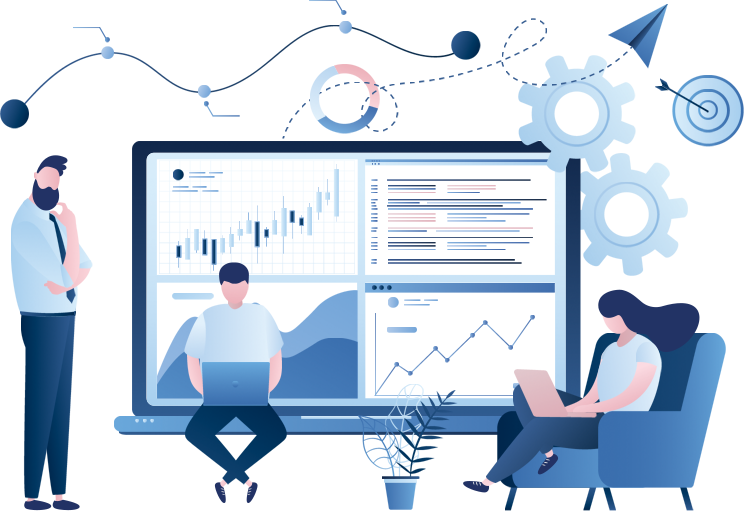Enabling today's hybrid, remote, and frontline workers means supporting unique device deployments on- and off-premises based on the nature of their work. Leverage Endpoint Central's wide device support across on-site and private and public cloud environments to support and enable your workforce in their day-to-day activities.
Devise and implement a comprehensive strategy that combines proactive policies like DLP, vulnerability detection and remediation, web protection, and privilege elevation prevention, with means to automate incident responses.
Automate the employee life cycle with self-service, facilitating them to access corporate resources as and when required, and avail timely troubleshooting and IT assistance. Deliver proactive assistance and support with continuous checks on employees' digital metrics.
Automate workflows to eliminate manual intervention across device management, security, and the user experience. Leverage Endpoint Central's insights-driven automation workflows to proactively detect and remediate device and app performance issues and security incidents, ensuring devices remain in their normal working state.
Mandate and maintain compliance with industry regulatory guidelines and compliance standards like HIPAA, GDPR, SOC2, PCI DSS, and CIS Controls using ready-made templates and automated remediation workflows.
Around the late 2000s, organizations increasingly started automating the administration activities that were otherwise being done manually. This market functioned under the name Client Management Tools.
We built Desktop Central right from scratch and launched as a Client Management Tool in 2005. Desktop Central, right from debut, stood apart from other vendors in the thoughtful provision of features like Distribution Server for bandwidth reduction, Power Management as a 'Go Green' initiative, etc.

Around 2010, mobile devices entered the radar of IT organizations. And in response, Mobile Device Management (MDM) was born. As mobility blurred the boundary between the personal and the professional, around 2012, MDM evolved into Enterprise Mobility Management (EMM) which offered increased security. EMM also supported BYOD among other things. It was this adaptation to BYOD then, that helped us survive the pandemic now.
It continued to grow as a stand-alone market since CMT vendors could not easily absorb EMM due to architectural constraints. But in 2013, we catered to this need and introduced EMM in Desktop Central. We became the only vendor after Microsoft to unify EMM and CMT into a single product!

Following this, MDM got redefined to ‘modern management’ with the increasing adoption of Windows 10. Modern management denotes the endpoint management that is delivered via cloud-enabled services.
In 2016, Desktop Central was added to AWS and Azure marketplace. We are one of the first vendors to provide EMM capabilities as well as support to both legacy Windows OS and Windows 10. This way, we bridged traditional management and modern management. We also equipped the users with zero touch enrollment and autopilot mode.

Following the launch of Windows 10, around 2018, organizations increasingly started looking for a single vendor and a single platform to manage desktops and mobile devices. This lead to the convergence of CMT and EMM into Unified Endpoint Management (UEM).
Catering to this trend, we enabled users to automate day-to-day device management activities - from onboarding to retirement, across hybrid workspace and highly heterogeneous OS ecosystems (including chromeOS and tvOS) and endpoints like desktops, smartphones, tablets, servers, point-of-sale devices, thin clients, IoT, wearables, kiosks and other network components. In 2020, we launched Desktop Central Cloud.
We expanded to deliver requirements like robust remote control and security capabilities like DLP, anti-ransomware, compliance with HIPAA, PCI, PCI DSS, FISM, CIS, etc., that go beyond traditional and modern device management. Having advocated for security right from our founding, we continued to provide a secure operating environment to our users.

Going forward, we believe the market is marching towards a hybrid environment with the mix and match of on-premises and cloud instances, virtual machines and physical machines, conventional workforce and distributed workforce, office and remote users. And we are ready for that! While not exhaustive, our roadmap includes tight integration between Endpoint Security Management and UEM, along with a feature-set that meets our users' ever-evolving needs.

ManageEngine is a pioneer in solving enterprise challenges around device management and security, and has demonstrated a history of innovating in the marketplace. Endpoint Central is ManageEngine's comprehensive UEM solution for managing and securing highly diversified device deployments, and providing heterogeneous OS support. It offers end-to-end life cycle management for both traditional and modern devices, robust remote support, and endpoint security capabilities using a single agent and workflow. Available both on-premises and as a SaaS tool, Endpoint Central is used by more than 25,000 enterprises globally and integrates with many third-party ITSM and IAM tools.












Gartner® Market Guide for Unified Endpoint Management Tools, 19 September 2023, Tom Cipolla, Dan Wilson, Craig Fisler, Sunil Kumar
GARTNER is a registered trademark and service mark of Gartner, Inc. and/or its affiliates in the U.S. and internationally and is used herein with permission. All rights reserved.
Gartner® does not endorse any vendor, product or service depicted in its research publications and does not advise technology users to select only those vendors with the highest ratings or other designation. Gartner® research publications consist of the opinions of Gartner’s research organization and should not be construed as statements of fact. Gartner® disclaims all warranties, expressed or implied, with respect to this research, including any warranties of merchantability or fitness for a particular purpose.